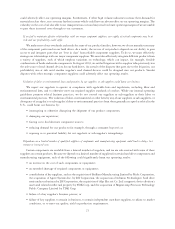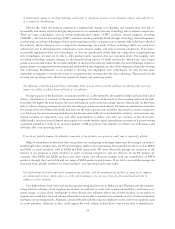Western Digital 2008 Annual Report Download - page 25
Download and view the complete annual report
Please find page 25 of the 2008 Western Digital annual report below. You can navigate through the pages in the report by either clicking on the pages listed below, or by using the keyword search tool below to find specific information within the annual report.Loss of market share with or by a key customer could harm our operating results.
During the year ended June 27, 2008, a large percentage of our revenue came from sales to our top 10 customers,
which accounted for 47% of our revenue. These customers have a variety of suppliers to choose from and therefore can
make substantial demands on us, including demands on product pricing and on contractual terms, which often results in
the allocation of risk to us as the supplier. Even if we successfully qualify a product with a customer, the customer
generally is not obligated to purchase any minimum volume of products from us and may be able to cancel an order or
terminate its relationship with us at any time. Our ability to maintain strong relationships with our principal customers
is essential to our future performance. If we lose a key customer, if any of our key customers reduce their orders of our
products or require us to reduce our prices before we are able to reduce costs, if a customer is acquired by one of our
competitors or if a key customer suffers financial hardship, our operating results would likely be harmed. In addition, if
customer pressures require us to reduce our pricing such that our gross margins are diminished, we could decide not to
sell our products to a particular customer, which could result in a decrease in our revenue.
Current or future competitors may gain a technology advantage or develop an advantageous cost structure that we cannot match.
It may be possible for our current or future competitors to gain an advantage in product technology, manufacturing
technology, or process technology, which may allow them to offer products or services that have a significant advantage
over the products and services that we offer. Advantages could be in capacity, performance, reliability, serviceability, or
other attributes.
Higher capacity storage needs have typically been better served by magnetic hard drives than flash memory as hard
drive manufacturers can offer better value at high capacities, while lower capacity needs have been successfully served by
solid state storage such as flash memory technology. Advances in magnetic, optical, semiconductor or other data storage
technologies could result in competitive products that have better performance or lower cost per unit of capacity than our
products. If we fail to be cost competitive against flash memory, we could be at a competitive disadvantage to companies
using semiconductor technology.
Further industry consolidation could provide competitive advantages to our competitors.
The hard drive industry has experienced consolidation over the past several years. Consolidation by our competitors
may enhance their capacity, abilities and resources and lower their cost structure, causing us to be at a competitive
disadvantage. Additionally, continued industry consolidation may lead to uncertainty in areas such as component
availability, which could negatively impact our cost structure.
Sales in the distribution channel are important to our business, and if we fail to maintain brand preference with our
distributors or if distribution markets for hard drives weaken, our operating results could suffer.
Our distribution customers typically sell to small computer manufacturers, dealers, systems integrators and other
resellers. We face significant competition in this channel as a result of limited product qualification programs and a significant
focus on price and availability of product. If we fail to remain competitive in terms of our technology, quality, service and
support, our distribution customers may favor our competitors, and our operating results could suffer. We also face significant
risk in the distribution market for hard drives. If the distribution market weakens as a result of a slowing PC growth rate,
technology transitions or a significant change in consumer buying preference from white box to branded PCs, or we experience
significant price declines due to oversupply in the distribution channel, then our operating results would be adversely affected.
The hard drive industry is highly competitive and can be characterized by significant shifts in market share among the major
competitors.
The price of hard drives has fallen over time due to increases in supply, cost reductions, technological advances and
price reductions by competitors seeking to liquidate excess inventories or attempting to gain market share. In addition,
rapid technological changes often reduce the volume and profitability of sales of existing products and increase the risk of
inventory obsolescence. We also face competition from other companies that produce alternative storage technologies like
flash memory. These factors, taken together, may result in significant shifts in market share among the industry’s major
participants. In addition, product recalls can lead to a loss of market share, which could adversely affect our operating results.
19
























